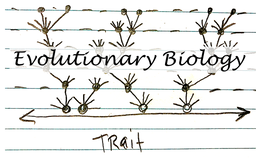Courses I currently revise and teach. If you click on each course icon, you can gain access to available curriculum currently under development (it is always under development) and associated materials. (This is a work in progress)
I also engage in the scholarship of teaching and learning and encourage and help my peers do the same. A couple of areas of interest and current emphasis include...
|
Graphs shows data from a two-stage exam designed to estimate the effects of individual preparation, cognitive challenge, and group composition on student performance in small groups. Small circles are individual scores and large circles are group scores for a 10-question two-stage exam. Numbers above graphs are estimates of variation in group performance due to specific variables.
|
...practicing scientific teaching
One of my goals is emphasis on treating teaching and learning as a science: propose hypotheses, design experiments to test hypothesis, collect data, and communicate the results. |
|
The graphs show a compilation of science process skills emphasis in two successive courses showing a lack of alignment within one course and limited alignment between the two courses. One is a content-heavy, largely lecture-based course (left) and the other is a student-centric, active learning course developed using the 3D-LAP.
|
...emphasizing assessment and curricular alignment within and across courses
Learning happens best when assessments are aligned with curriculum and both are aligned with research-supported best practices (see Laverty et. al. 2016 and other papers from Melanie Cooper's group at Michigan State University). |
|
Graphs show the proportion of students who were unsuccessful in two successive courses over time (x-axis is year + semester) For both courses, there is a strong effect of instructor on student success.
|
...using data for revision of teaching and driving professional development
The goal is to collect data on student success across various courses and instructors and use the data for promoting discussions about pedagogy and curricular alignment within and among departments in ways that improve education and outcomes. |
|
Students design and build two generations of bridges to investigate general principles of evolution and develop rapport with their peers (see Carscadden et al. 2019)
|
...developing, testing, and sharing curriculum
Developing and testing curriculum is a creative and fun process. Ideally, development and testing is followed by making the efforts public through publication in journals (like CourseSource and Journal of College Science Teaching) |
|
Visualization of the development of a connected learning community in Evolutionary Biology (see Measuring Social Interactions...)
|
...fostering and quantifying learning communities
Students sense of belonging and the development of learning communities can be analyzed and visualized using the tools of social network analysis. Network data are useful for estimating the effect of curricula and teaching strategies on connecting students into an academic community with effects that may transcend their time at the University. |









